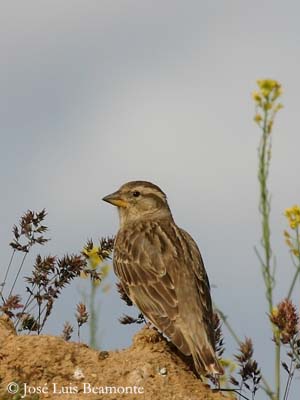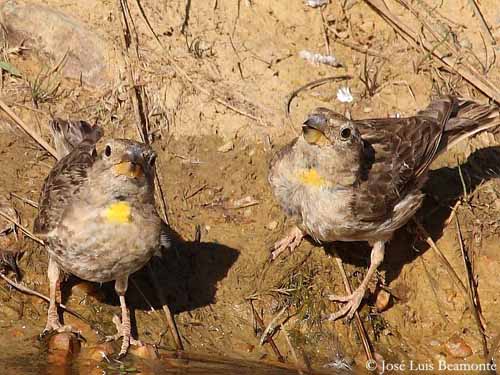
DIET:
The Rock Sparrow feeds on cereal rains, all kinds of seeds from forest plants, berries and fruits in autumn and winter.
During spring and summer, it feeds mainly on insects, grasshoppers and caterpillars, but it also takes cherries and other fruits.
PROTECTION / THREATS / STATUT:
The Rock Sparrow is common, mainly in Spain, and this species is not threatened at this time. It is well present in protected areas.
Fr: Moineau soulcie
All : Steinsperling
Esp : Gorrión Chillón
Ital: Passera lagia striata
Nd: Rotsmus
Sd: Stensparv
Photographers:
José Luís Beamonte
Pájaros de España
Nicole Bouglouan
PHOTOGRAPHIC RAMBLE
Text by Nicole Bouglouan
Sources:
HANDBOOK OF THE BIRDS OF THE WORLD Vol 14 by Josep del Hoyo-Andrew Elliot-David Christie - Lynx Edicions –
ISBN: 9788496553507
THE HANDBOOK OF BIRD IDENTIFICATION FOR EUROPE AND THE WESTERN PALEARCTIC by Mark Beaman, Steve Madge - C.Helm - ISBN: 0713639601
ENCYCLOPEDIE DES OISEAUX DE FRANCE ET D’EUROPE – de Peter Hayman et Rob Hume - Flammarion – ISBN : 2082009920
Pájaros de España (JL Beamonte)
XENO-CANTO – Sharing Birds sounds from around the world
Rock Sparrow
Petronia petronia
Passeriforme Order – Passeridae Family
BIOMETRICS:
Length: 14-15 cm
Weight: 26-39 g
DESCRIPTION:
The Rock Sparrow is very similar to the female House Sparrow, but it is bulkier, with shorter, spotted white tail, stronger bill and larger legs.
We can see pale stripes on the head, one starting from the eyes and running to the nape, and the other from the forehead, through the crown and to the nape. On the rear eyes region, at ear-tuft level and on the rear crown, some dark patches contrast with the pale eyebrows.
We can see a typical yellow patch on the throat, but often difficult to see.

The upperparts are dark brown with blackish patches and streaks. The tips of the rectrices are spotted white, well visible in flight.
The underparts are whitish streaked brown, extending to the flanks and undertail feathers.
The bill is strong and conical. It is brown, from horn to dark brown on the upper mandible, and yellowish on the lower mandible. The eyes are dark brown. Legs and feet are pale brown or pinkish-brown.
Both sexes are similar.
The juvenile resembles adults, but it lacks the yellow throat-patch and has browner plumage.
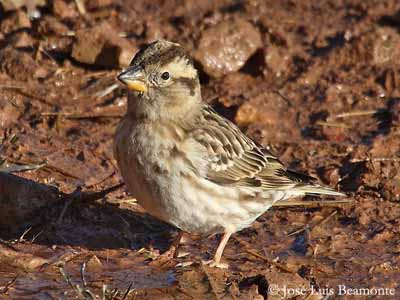
We can find several subspecies which differ in size and intensity of plumage colours.
VOICE: SOUNDS BY XENO-CANTO
The Rock Sparrow’s typical call is mostly a loud whistle uttered when they are in groups “pii-yip” or “pii-yuii”. Other calls include various warblers typical of sparrows, but softer and more musical than those of House Sparrow.
In flight, it gives a soft, nasal “dlui”. We also can hear short and harsh ‘uii-iip” or “birii”.
These birds can sing in chorus or alone, with variants from hard calls to abrupt silence.
HABITAT:
The Rock Sparrow frequents stony areas with short grass, arid and stony fields, mountainous areas and monuments. This is a typical Mediterranean species.
RANGE:
The Rock Sparrow breeds in southern Europe, from Iberian Peninsula and western North Africa, through southern Europe and centre of Asia.
The Asian populations migrate southwards or perform altitudinal movements after the breeding season and during winter.
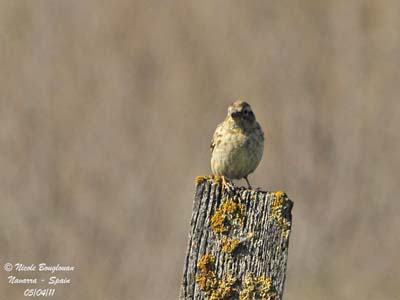
BEHAVIOUR:
The Rock Sparrow is very shy during the breeding season, but outside this period, this species is gregarious.
When on the ground, it walks but does not hop, and remains fairly shy. In addition, it is very timid and anxious and can go completely unnoticed.
It comes close to humans, habitations and tracks.
It perches in open in upright stance, in order to display the yellow throat patch. It also erects the top of the crown. This bird can be aggressive in spite of its quiet appearance.
To feed, it pecks among the stones, in the crevices of the walls in monuments, in rocks and ruins, to find grasses and seeds, and also small berries.
During the breeding season, it catches insects mainly on the ground, but can take some preys on the wing.
At the end of the nesting period, the young of the first brood gather with adults and youngest birds, and form flocks which disperse into drier areas.
The courtship displays occur soon. As soon as March, the pairs occupy their usual breeding territories.
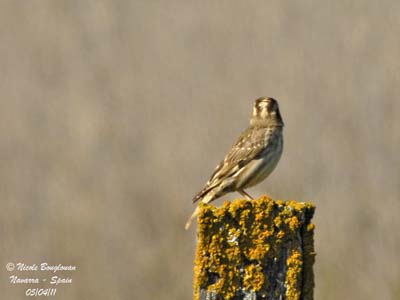
FLIGHT:
The Rock Sparrow has fast, undulating flight.
During the courtship displays, the males perform almost bat-like flights with broadly spread wings. Glides down to a perch close to that of female are usual.
REPRODUCTION:
The Rock Sparrow starts to breed in April. The flight displays by males become more frequent from mid-April.
Usually, the nest is built inside a rock crevice, in stone wall or in hole in house or monument. They can be seen in porches of houses in mountain villages. Others are in hollow tree trunks, at variable height, but usually up to two metres above the ground. They can also occupy abandoned rabbit’s burrows in earthy banks, well hidden among the vegetation.
The nest is a mound of straw, dry grasses, rootlets, wool, hair and numerous feathers. When in open or in large hollow, the bird gathers the nest material above, in order to form a kind of roof.
The female lays 4-5 eggs in April-May, sometimes six at higher altitude where a second clutch is not sure. The eggs are white, spotted brown or blackish. Usually, the larger base is darker, but others eggs can be very pale with greyish speckles, or almost entirely greenish-white.
The incubation lasts about 12-15 days, by the female. She is fed by the male during this period. At hatching, the chicks are partially covered in down.
Both adults rear them carefully, but they grow very slowly and they remain at nest at least 20 to 22 days.
The second clutch occurs in June-July and starts about height days after the first young fledge. They are reared by the male while the female incubates. The same nest is often reused for both clutches.
